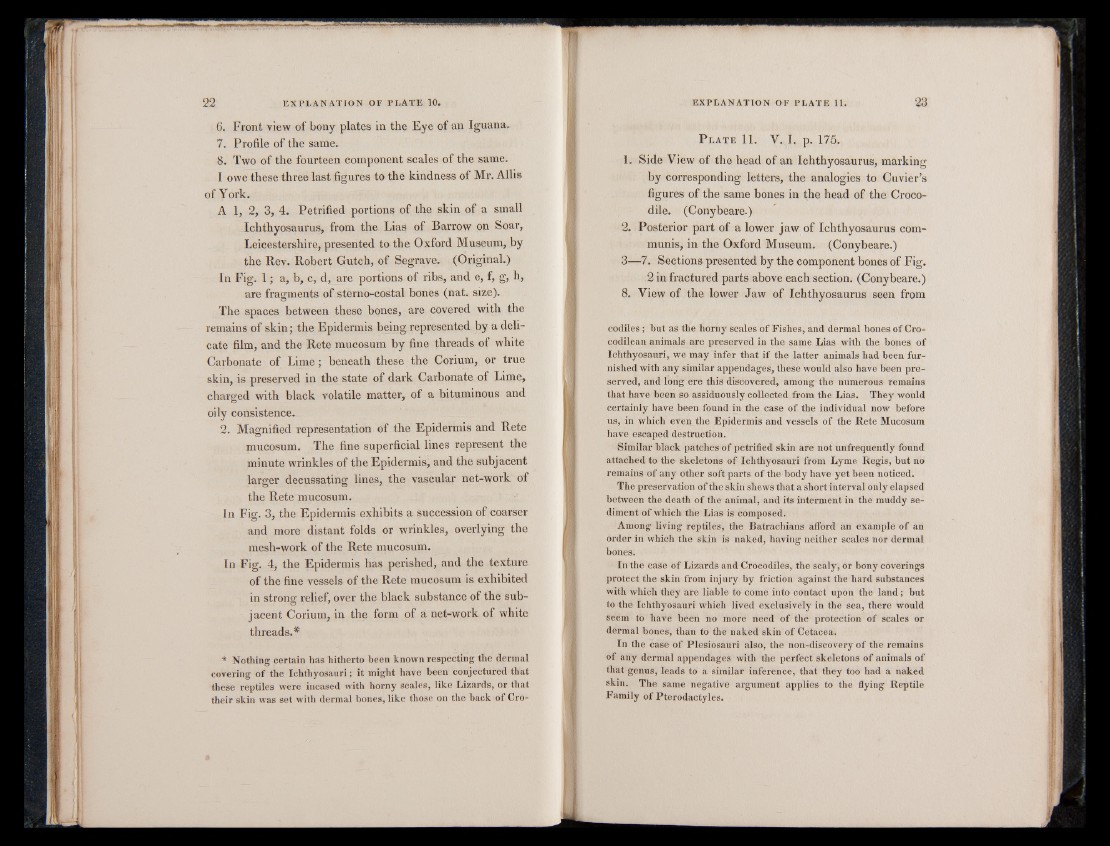
6. Front view of bony plates in the Eye of an Iguana.
7. Profile of the same.
8. Two of the fourteen component scales of the same.
I owe these three last figures to the kindness of Mr. Allis
of York.
A 1, 2, 3, 4. Petrified portions of the skin of a small
Ichthyosaurus, from the Lias of Barrow on Soar,
Leicestershire, presented to the Oxford Museum, by
the Rev. Robert Gutch, of Segrave. (Original.)
In Fig. 1; a, b, c, d, are portions of ribs, and e, f, g, h,
are fragments of sterno-costal bones (nat. size).
The spaces between these bones, are covered with the
remains of skin; the Epidermis being represented by a delicate
film, and the Rete mucosum by fine threads of white
Carbonate of Lime; beneath these the Corium, or true
skin, is preserved in the state of dark Carbonate of Lime,
charged with black volatile matter, of a bituminous and
oily consistence.
2. Magnified representation of the Epidermis and Rete
mucosum. The fine superficial lines represent the
minute wrinkles of the Epidermis, and the subjacent
larger decussating lines, the vascular net-work of
the Rete mucosum.
In Fig. 3, the Epidermis exhibits a succession of coarser
and more distant folds or wrinkles, overlying the
mesh-work of the Rete mucosum.
In Fig. 4, the Epidermis has perished, and the texture
of the fine vessels of the Rete mucosum is exhibited
in strong relief, over the black substance of the subjacent
Corium, in the form of a net-work of white
threads.*
* Nothing certain has hitherto been known respecting the dermal
covering of the Ichthyosauri; it might have been conjectured that
these reptiles were incased with horny scales, like Lizards, or that
their skin was set with dermal bones, like those on the back of Cro-
P late 11. V. I. p. 175.
1. Side View of the head of an Ichthyosaurus, marking
by corresponding letters, the analogies to Cuvier’s
figures of the same bones in the head of the Crocodile.
(Conybeare.)
2. Posterior part of a lower jaw of Ichthyosaurus communis,
in the Oxford Museum. (Conybeare.)
3—7. Sections presented by the component bones of Fig.
2 in fractured parts above each section. (Conybeare.)
8. View of the lower Jaw of Ichthyosaurus seen from
codiles; but as the horny scales of Fishes, and dermal bones of Cro-
codilean animals are preserved in the same Lias with the bones of
Ichthyosauri, we may infer that if the latter animals had been furnished
with any similar appendages, these would also have been preserved,
and long ere this discovered, among the numerous remains
that have been so assiduously collected from the Lias. They would
certainly have been found in the case of the individual now before
us, in which even the Epidermis and vessels of the Rete Mucosum
have escaped destruction.
Similar black patches of petrified skin are not unfrequently found
attached to the skeletons of Ichthyosauri from Lyme Regis, but no
remains of any other soft parts of the body have yet been noticed.
The preservation of the skin shews that a short interval only elapsed
between the death of the animal, and its interment in the muddy sediment
of which the Lias is composed.
Among living reptiles, the Batrachians afford an example of an
order in which the skin is naked, having neither scales nor dermal
bones.
In the case of Lizards and Crocodiles, the scaly, or bony coverings
protect the skin from injury by friction against the hard substances
with which they are liable to come into contact upon the land; but
to the Ichthyosauri which lived exclusively in the sea, there would
seem to have been no more need of the protection of scales or
dermal bones, than to the naked skin of Cetacea,
In the case of Plesiosauri also, the non-discovery of the remains
of any dermal appendages with the perfect skeletons of animals of
that genus, leads to a similar inference, that they too had a naked
skin. The same negative argument applies to the flying Reptile
Family of Pterodactyles.